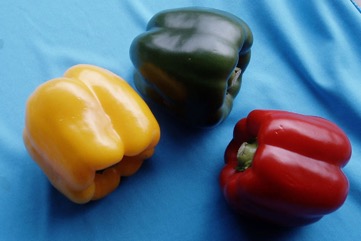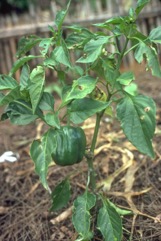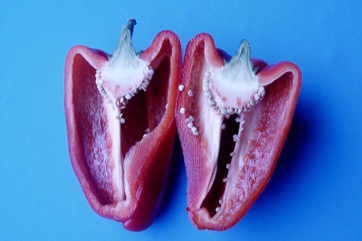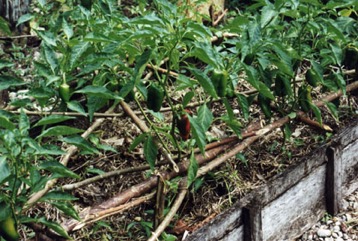Capsicum

A tropical or subtropical plant. Plants grow from sea level up to about 2400 m altitude. They are killed by frost. Soils need to be well drained and fertile. The fruit and plants can rot in the middle of the wettest seasons. They need a temperature above 4°C. A night temperature of 16-18°C and a day temperature of 26-28°C is best. A pH of 5.4-6.9 is suitable. They suit plant hardiness zones 8-12.
Also known as:
Adimaeti, Aji, Aji dulce, Aji rojo, Bell peppers, Chilar de monte, Epeba, Gochu, Kamalra, Kamulali, Khursani, Laat jiu, Libokeg, Malu miris, Milagai, Mirch, Miris, Mixamixo, Ndungu zi mafofolo, Ngayok, Ot, Perec, Pilopilo, Pimentao, Pirpiri, Prik chee faa, Tattasai, Togarashi, Tsi-tra-ka
Edible Portion
- Fruit, Leaves, Herb, Spice, Vegetable
Where does Capsicum grow?
Found in: Africa, Albania, Angola, Asia, Australia, Austria, Bangladesh, Barbados, Benin, Bhutan, Bolivia, Brazil, British Indian Ocean Terr., BIOT, Bulgaria, Burkina Faso, Cambodia, Caribbean, Caucasus, Central Africa, Central America, Central Asia, China, Colombia, Congo DR, Cook Islands, Costa Rica, Cuba, Dominican Republic, East Africa, East Timor, Ecuador, Egypt, Ethiopia, Fiji, FSM, Georgia, Ghana, Grenada, Guam, Guatemala, Guiana, Guianas, Guyana, Haiti, Hawaii, Himalayas, Honduras, Hungary, India, Indochina, Indonesia, Italy, Japan, Kazakhstan, Kenya, Kiribati, Korea, Kyrgyzstan, Laos, Macedonia, Madagascar, Malawi, Malaysia, Marquesas, Mexico, Moldova, Mozambique, Myanmar, Nauru, Nepal, Niger, Nigeria, North Africa, North America, Northeastern India, Pacific, Pakistan, Papua New Guinea, PNG, Peru, Philippines, Pohnpei, Romania, Rotuma, Sao Tome and Principe, SE Asia, Serbia, Sierra Leone, Sikkim, Slovenia, Somalia, South Africa, Southern Africa, South America, Spain, Sri Lanka, St Helena, Suriname, Switzerland, Taiwan, Tajikistan, Tasmania, Thailand, Timor-Leste, Tonga, Turkey, Tuvalu, Uganda, Ukraine, Uruguay, United States, Uzbekistan, Vanuatu, Venezuela, Vietnam, West Africa, West Indies, Yugoslavia, Zambia, Zimbabwe
Notes: There are 10 Capsicum species. The various Capsicum annuum varieties may be synonyms of Capsicum annuum. It possibly has anti-cancer properties.
Status: In Papua New Guinea it is becoming a popular vegetable to eat raw.
Growing Capsicum
Cultivation: Plants are grown from seed. Both self and cross pollination occur. It is possible to save your own seed. Seed will keep for 2 to 3 years. Seeds germinate in 6 - 10 days. Plants can be transplanted. Plants need to be about 50 cm apart. About 50% of flowers set fruit.
Edible Uses: The fruit are edible raw or cooked. They are stuffed, roasted, fried, preserved and use as flavouring. The leaves are edible cooked.
Production: The first fruit can be harvested after 3-4 months.
Nutrition Info
per 100g edible portion| Edible Part | Energy (kcal) | Protein (g) | Iron (mg) | Vitamin A (ug) | Vitamin c (mg) | Zinc (mg) | % Water |
|---|---|---|---|---|---|---|---|
| Fruit green raw | 15 | 0.9 | 0.4 | 59 | 100 | 0.2 | 93.5 |
| Fruit green boiled | 14 | 0.9 | 0.4 | 59 | 60 | 0.2 | 93.7 |
| Fruit yellow raw | 27 | 1 | 0.5 | 24 | 183.5 | 0.2 | 92 |
| Leaves | 53 | 5.8 | 1.4 | - | 68 | - | 82.1 |
Capsicum Photos




References
Abbiw, D.K., 1990, Useful Plants of Ghana. West African uses of wild and cultivated plants. Intermediate Technology Publications and the Royal Botanic Gardens, Kew. p 35
Anderson, E. F., 1993, Plants and people of the Golden Triangle. Dioscorides Press. p 205
Awas, T., 1997, A Study on the Ecology and Ethnobotany of Non-cultivated Food Plants and Wild Relatives of Cultivated crops in Gambella Region, Southwestern Ethiopia. Addis Ababa University. p 67
Balemie, K., & Kebebew, F., 2006, Ethnobotanical study of wild edible plants in Derashe and Kucha Districts, South Ethiopia. Journal of Ethnobiology and Ethnomedicine.
Bennett, B. C., 1990, Useful Plants of Amazonian Ecuador. US Agency for International Development. Fifth Progress Report. New York Botanical Gardens. p 39
Bernholt, H. et al, 2009, Plant species richness and diversity in urban and peri-urban gardens of Niamey, Niger. Agroforestry Systems 77:159-179
Bianchini, F., Corbetta, F., and Pistoia, M., 1975, Fruits of the Earth. Cassell. p 94
Brickell, C. (Ed.), 1999, The Royal Horticultural Society A-Z Encyclopedia of Garden Plants. Convent Garden Books. p 226
Brouk, B., 1975, Plants Consumed by Man. Academic Press, London. p 92, 286
Burkill, H. M., 1985, The useful plants of west tropical Africa, Vol. 1. Kew.
Bussman, R. W., et al, 2016, A comparative ethnobotany of Khevsureti, Samtskhe-Javakheti, Tusheti, Svaneti, and Racha-Lechkhumi, Republic of Georgia (Sakartvelo), Caucasus. Journal of Ethnobiology and Ethnomedicine.
Bussman, R. W. et al, 2017, Ethnobotany of Samtskhe-Javakheti, Sakartvelo (Republic of Georgia), Caucasus. Indian Journal of Traditional Knowledge Vol. 16(1) pp 7-24
Cheifetz, A., (ed), 1999, 500 popular vegetables, herbs, fruits and nuts for Australian Gardeners. Random House p 50
Chin, H. F., 1999, Malaysian Vegetables in Colour. Tropical Press. p 86 (As Capsicum annuum var. acuminatum)
Ching, L. S. & Mohamed, S., 2001, Alpha-Tocopherol Content in 62 Edible Tropical Plants. J. Agric. Food Chem. 2001, 49, 3101−3105 (red)
Chizmar Fernandez, C., et al, 2009, Plantas comestibles de Centroamerica. Instituto de Biodiversidad, Costa Rica. p 299
Creasy, R., 2000, The Edible Asian Garden. Periplus p 52
Dangol, D. R. et al, 2017, Wild Edible Plants in Nepal. Proceedings of 2nd National Workshop on CUAOGR, 2017.
Dansi, A., et al, 2008, Traditional leafy vegetables and their use in the Benin Republic. Genet Resour Crop Evol (2008) 55:1239–1256
Ekman Herbarium records Haiti
Epenhuijsen C.W. van., 1974, Growing Native vegetables in Nigeria. FAO Rome, p 44
Esperanca, M. J., 1988. Surviving in the wild. A glance at the wild plants and their uses. Vol. 1. p 182
Facciola, S., 1998, Cornucopia 2: a Source Book of Edible Plants. Kampong Publications, p 231
Flora of China. www.eFloras.org
Flora of Pakistan. www.eFloras.org
Foo, J.T.S.(ed), 1996, A Guide to Common Vegetables. Singapore Science Foundation. p 130
Food Composition Tables for use in Africa FAO http://www.fao.org/infoods/directory No. 746 (As Capsicum abyssinicum)
Fowler, D. G., 2007, Zambian Plants: Their Vernacular Names and Uses. Kew. p 61
Fox, F. W. & Young, M. E. N., 1982, Food from the Veld. Delta Books. p 342
French, B.R., 1986, Food Plants of Papua New Guinea, A Compendium. Asia Pacific Science Foundation p 136
French, B.R., 2010, Food Plants of Solomon Islands. A Compendium. Food Plants International Inc. p 154
Goode, P., 1989, Edible Plants of Uganda. FAO p 26
Grubben, G. J. H. and Denton, O. A. (eds), 2004, Plant Resources of Tropical Africa 2. Vegetables. PROTA, Wageningen, Netherlands. p 155
Grubben, G.J.H. & El Tahir Ibrahim Mohamed, 2004. Capsicum annuum L. [Internet] Record from Protabase. Grubben, G.J.H. & Denton, O.A. (Editors). PROTA (Plant Resources of Tropical Africa), Wageningen, Netherlands. < http://database.prota.org/search.htm>. Accessed 14 October 2009. (Includes other varieties)
Hedrick, U.P., 1919, (Ed.), Sturtevant's edible plants of the world. p 154
Heiser, C.B., 1979, Peppers, in Simmonds, N.W., (ed), Crop Plant Evolution. Longmans. London. p 265
Hermandez Bermejo, J.E., and Leon, J. (Eds.), 1994, Neglected Crops. 1492 from a different perspective. FAO Plant Production and Protection Series No 26. FAO, Rome. p 12
Huxley, A. (Ed.), 1977, The Encyclopedia of the Plant Kingdom. Chartweil Books. p 56
Jardin, C., 1970, List of Foods Used In Africa, FAO Nutrition Information Document Series No 2.p 63 (Also as Capsicum conicum) and (As Capsicum abyssinicum)
Kapelle, M., et al, 2000, Useful plants within a Campesino Community in a Costa Rican Montane Cloud Forest. Mountain Research and Development, 20(2): 162-171
Kebebew, M. & Leta, G., 2016, Wild Edible Plant Bio-diversity and Utilization System in Nech Sar National Park, Ethiopia. International Journal of Bio-resource and Stress Management 2016, 7(4):885-896
Khanal, R., et al, 2014, Documenting abundance and use of underutilized plant species in the mid hill region of Nepal. ECOPRINT 21: 63-71, 2014
Kiple, K.F. & Ornelas, K.C., (eds), 2000, The Cambridge World History of Food. CUP p 433
Kuo, W. H. J., (Ed.) Taiwan's Ethnobotanical Database (1900-2000), http://tk.agron.ntu.edu.tw/ethnobot/DB1.htm
Kybal, J., 1980, Herbs and Spices, A Hamlyn Colour Guide, Hamlyn Sydney p 64
Latham, P., 2004, Useful Plants of Bas-Congo province. Salvation Army & DFID p 68
Lautenschläger, T., et al, 2018, First large-scale ethnobotanical survey in the province of Uíge, northern Angola. Journal of Ethnobiology and Ethnomedicine (2018) 14:51
Lazarides, M. & Hince, B., 1993, Handbook of Economic Plants of Australia, CSIRO. p 47
Lembogi Biologi Nasional, 1980m Sayur-sayuran. Balai Pustaka, Jakarta. p 18
Lentz, D. L., 1986, Ethnobotany of the Jicaque of Honduras. Economic Botany 40(2):210-219
Macmillan, H.F. (Revised Barlow, H.S., et al) 1991, Tropical Planting and Gardening. Sixth edition. Malayan Nature Society. Kuala Lumpur. p 344
Maghirang, R. G., et al, 2018. Ethnobotanical Studies of Some Plants Commonly Used as Vegetables in Selected Provinces of the Philippines. Journal of Nature Studies. 17(2), 30-43.
Martin, F.W. & Ruberte, R.M., 1979, Edible Leaves of the Tropics. Antillian College Press, Mayaguez, Puerto Rico. p 46, 219
Miguel, E., et al, 1989, A checklist of the cultivated plants of Cuba. Kulturpflanze 37. 1989, 211-357
Molla, A., Ethiopian Plant Names. http://www.ethiopic.com/aplants.htm (As Capsicum abyssinicum)
Murakami, A. et al, 2014, Screening for the In Vitro Anti-tumor-promoting Activities of Edible Plants from Malaysia. Bioscience, Biotechnology, and Biochemistry, 64:1, 9-16.
Murtem, G. & Chaudhrey, P., 2016, An ethnobotanical note on wild edible plants of Upper Eastern Himalaya, India. Brazilian Journal of Biological Sciences, 2016, v. 3, no. 5, p. 63-81
Niwano, Y. et al., 2009, Extensive Screening for Plant Foodstuffs in Okinawa, Japan with Anti-Obese Activity on Adipocytes, in vitro. Plant Foods in Human Nutrition 64:6-10
Norrington, L., & Campbell, C., 2001, Tropical Food Gardens. Bloomings Books. p 26
Owen, S., 1993, Indonesian Food and Cookery, INDIRA reprints. p 50
Peekel, P.G., 1984, (Translation E.E.Henty), Flora of the Bismarck Archipelago for Naturalists, Division of Botany, Lae, PNG. p 492, 495
Phon, P., 2000, Plants used in Cambodia. © Pauline Dy Phon, Phnom Penh, Cambodia. p 132
Pieroni, A., 2008, Local plant resources in the ethnobotany of Theth, a village in the Northern Albanian Alps. Genet Resour Crop Evol (2008) 55:1197–1214
Plants for a Future database, The Field, Penpol, Lostwithiel, Cornwall, PL22 0NG, UK. http://www.scs.leeds.ac.uk/pfaf/
Plants of Haiti Smithsonian Institute http://botany.si.edu/antilles/West Indies
Purseglove, J.W., 1968, Tropical Crops Dicotyledons, Longmans. p 524
Rajapaksha, U., 1998, Traditional Food Plants in Sri Lanka. HARTI, Sri Lanka. p 469
Rangel-Landa, S., et al, 2017, Sociocultural and ecological factors influencing management of edible and non-edible plants: the case of Ixcatlan, Mexico. Journal of Ethnobiology and Ethnomedicine. 13:59
Rashid, H. E., 1977, Geography of Bangladesh. Westview. p 276
Rosero-Toro, et al, 2018, Cultural significance of the flora of a tropical dry forest in the Doche vereda (Villavieja, Huila, Colombia). Journal of Ethnobiology and Ethnomedicine (2018) 14:22 p 12
Ruiters-Welcome, A. K., 2019, Food plants of southern Africa. Ph.D. thesis. Univ. of Johannesburg p 102
Salako, V. K. et al, 2013, Home gardens: an assessment of their biodiversity and potential contribution to conservation of threatened species and crop wild relatives in Benin. Genet Resour Crop Evol
Samuels, J., 2015, Biodiversity of Food Species of the Solonaceae Family: A Preliminary Taxonomic Inventory of Subfamily Solanoideae. Resources 2015, 4. 277-322
Seidemann J., 2005, World Spice Plants. Economic Usage, Botany, Taxonomy. Springer. p 81
Siemonsma, J. S. and Piluek, K. (Eds), 1994, Plant Resources of South-East Asia No. 8 Vegetables. Prosea Foundation, Bogor, Indonesia, p 136
Small, E., 2009, Top 100 Food Plants. The world's most important culinary crops. NRC Research Press. p 177
Song, M., et al, 2013, Traditional knowledge of wild edible plants in Jeju Island, Korea. Indian Journal of Traditional Knowledge. 12(2) pp 177-194
Staples, G.W. and Herbst, D.R., 2005, A tropical Garden Flora. Bishop Museum Press, Honolulu, Hawaii. p 532
Sukenti, K., et al, 2016, Ethnobotanical study on local cuisine of the Sasak tribe in Lombok Island, Indonesia. Journal of Ethnic Foods. 3 (2016) 189-200 p 198
Terra, G.J.A., 1973, Tropical Vegetables. Communication 54e Royal Tropical Institute, Amsterdam, p 35
Thaman, R.R., 1976, The Tongan Agricultural System, University of the South Pacific, Suva, Fiji. p 386
Thaman, R. R, 2016, The flora of Tuvalu. Atoll Research Bulletin No. 611. Smithsonian Institute p 114
Tindall, H.D., & Williams, J.T., 1977, Tropical Vegetables and their Genetic Resources, International Board for Plant Genetic Resources, Rome, p 30
Tindall, H.D., 1983, Vegetables in the Tropics, Macmillan p 347
Topp, J. M. W., 1988, An Annotated Check List of the Flora of Diego Garcia, British Ocean Territory. Atoll Research Bulletin No. 313
Tredgold, M.H., 1986, Food Plants of Zimbabwe. Mambo Press. p 39
USDA, ARS, National Genetic Resources Program. Germplasm Resources Information Network - (GRIN). [Online Database] National Germplasm Resources Laboratory, Beltsville, Maryland. Available: www.ars-grin.gov/cgi-bin/npgs/html/econ.pl (10 April 2000)
Vickery, M.L. and Vickery, B., 1979, Plant Products of Tropical Africa, Macmillan. p 45
Vlkova, M., et al, 2015, Edible Plants Sold on Marginal Rural Markets in Fergana Valley, Southern Kyrgyzstan. Bulgarian Journal of Agricultural Science, 21 (No 2) 2015, 243–250
Walter, A. & Lebot, V., 2007, Gardens of Oceania. ACIAR Monograph No. 122. p 259
Williamson, J., 2005, Useful Plants of Malawi. 3rd. Edition. Mdadzi Book Trust. p 55
World Checklist of Useful Plant Species 2020. Royal Botanic Gardens, Kew
Yeshi, K. et al, 2017, Taxonomical Identification of Himalayan Edible Medicinal Plants in Bhutan and the Phenolic Contents and Antioxidant Activity of Selected Plants. TBAP 7 (2) 2017 pp 89 - 106
Zaldivar, M. E., et al, 2002, Species Diversity of Edible Plants Grown in Homegardens of Chibehan Amerindians from Costa Rica. Human Ecology, Vol. 30, No. 3, pp. 301-316